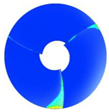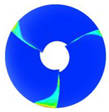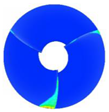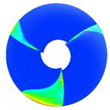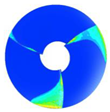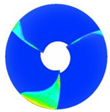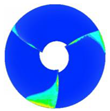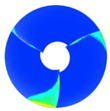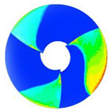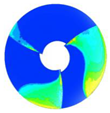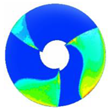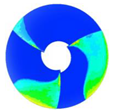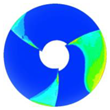Abstract
To investigate the transient characteristics of high-speed axial flow water-jet pumps during start-up and emergency acceleration as well as to analyze how different accelerations affect the performance of internal flow, the k–ω turbulence model of the SST model and Zwart cavitation model were used to perform unsteady simulation on an impeller rotating at a speed of 1850. The steady-state numerical simulation method was verified by the experimental data, the numerical calculation results were basically consistent with the experimental data, the margin of error was within 5%, and the numerical simulation method was reliable. The results show that there was an obvious transient effect in the process of variable speed, and the thrust reached a stable state later than the speed. The buffer times for start-up times of 1 s, 2 s, and 3 s were 0.0394 s, 0.0375 s, and 0.0282 s, respectively, and the buffer times for the acceleration times of 0.5 s, 1.0 s, and 1.5 s were 0.0330 s, 0.0273 s, and 0.0230 s, respectively. The greater the acceleration, the more serious the flow rate and thrust lag behind the speed, and the greater the impact thrust. Under the same acceleration, the buffer time required in the start-up process was 19.3~22.6% longer than that in the acceleration process. During the change in speed of the high-speed water-jet pump, the vortex core area of the suction surface (SS) first appeared on the side of the shroud at the inlet, increased with the increase in the rotational speed, and developed toward the middle of the impeller. However, after the flow was stabilized, the vortex core region gradually shrank and eventually disappeared. When the rotational speed reached 0.6 times the design speed, cavitation occurred at the leading edge (LE) of the blade, and the cavitation area increased with the increase in the rotational speed. When reaching the same speed, the greater the acceleration, the more serious the cavitation. Under the design speed, that is, 6000 r/min, the cavitation volume fraction of the 1 s start-up process was 7.32%, the 2 s start-up process was 5.84%, the 3 s start-up process was 5.32%, and the 0.5 s acceleration process was 6.86%. The cavitation volume fraction of the 1 s acceleration process was 5.04%, and that of the 1.5 s acceleration process was 4.23%. Under the same acceleration, the cavitation volume fraction of the start-up process was 6.7~25% larger than that of the acceleration process. Compared with the start-up process and acceleration process under the same acceleration, the accelerated process had a smaller region of vortex core, stronger anti-cavitation ability, and more stable flow than the start-up process. During the actual operation process of the water-jet pump, it is advisable to use smaller accelerations and segmented accelerations as much as possible until the design speed is reached. The research findings serve as a foundation for future investigations into the transient characteristics of high-speed water-jet pumps operating under variable speed conditions.
1. Introduction
Compared with the traditional propeller propulsion method [1], water-jet pumps have high propulsion efficiency, low vibration and noise, good maneuverability, low underwater acoustic signal, strong adaptability to changing operating conditions as well as good anti-cavitation performance when running at high speed, and is widely used in high-speed, high-performance ships, amphibious vehicles, and other vehicles [2]. In recent years, more and more people have been involved in the research of water-jet pumps, mainly focusing on the propulsion performance of water-jet pumps [3,4,5], cavitation performance [6,7,8], optimization analysis [9,10,11], etc., and considerable progress has been made. However, during the practical operation of the water-jet pump, the variable speed condition will cause strong transient performance changes, which will have a negative impact on the thrust, cavitation performance, internal flow field, pressure pulsation, etc., thus affecting the stable operation of the ship. Therefore, it is necessary to study the hydrodynamic characteristics of transient characteristics in the process of variable speed.
There are two main ways to study the start-up transient characteristics of pumps: experimental research and numerical simulation research. Numerous scholars have conducted experimental research on the start-up state of vane pumps. Lu [12] set up an experimental bench to measure the cavitation and vibration of the pump at different accelerations during the steady state and rapid start-up state. The findings indicate a strong correlation between cavitation and vibration. In the rapid start-up process at different acceleration times, the pump head has two peaks due to flow shock and pump hump, and short acceleration time leads to cavitation suppression. Duplaa [13] conducted a rapid start-up experimental study on a centrifugal pump under cavitation conditions and described the operation characteristics of the centrifugal pump by flow rate, head, and speed. Yu-Liang Zhang [14] et al. explored the transient hydrodynamic characteristics of self-priming pumps in fast-start and slow-start states through comparative experimental research. Yu-Liang Zhang [15] et al. conducted an experimental study on the transient characteristics of a low-specific speed centrifugal pump during the fast-start process. They obtained the laws governing the change in speed, flow, and head. They also calculated additional theoretical heads for quantitative analysis during the start-up process. Dazhuan Wu [16] et al. constructed a confined experimental bench to investigate the hydrodynamic traits of a centrifugal pump under transient operation while experiencing cavitation. It was found that there was a delay in the cavitation of the pump during the fast start-up phase. Wei Li [17] et al. established an elbow structure equipped with a visual port and utilized the PIV method to capture the actual flow field of the mixed-flow pump’s inlet section during the start-up process. The results showed that vortices were present at the impeller inlet during the initial phase, obstructing the flow passage. Qiao Li [18] et al. conducted various experiments to investigate diverse centrifugal pump-ball valve coupling methods to examine the transient characteristics of the start-up phase of the valve system and how to achieve greater flow acceleration through the valve.
However, the requirements for experimental research are high, and with the continuous upgrading and development of computer hardware computing power and algorithms, numerical simulation can accurately depict changes in the real flow field [19]. Fu, S [20] initially confirmed the accuracy of the numerical simulation for the start-up of the axial flow pump by conducting experiments, and then deeply explored the influence of the transient flow on the instantaneous pressure of the pump under unregulated conditions. The results showed that the instantaneous impact head reached a peak of 1.87 times the rated head. Zheng [21] analyzed the relationship between the strong transient effect and saddle region during the rapid start-up of the water-jet pump by numerical simulation. The velocity triangle method was used to analyze the flow dynamics at different openings. The results showed that the saddle area of the water-jet pump was 0.45 times to 0.65 times the rated flow. Ren [22] studied a mixed-flow pump with a speed of 1634 r/min to investigate the influence of different start-up schemes on the flow field and optimize it. Li [23] simulated the acceleration process of the water-jet pump by numerical simulation, and the results showed that the cavitation of the water-jet pump can be avoided by calculating a reasonable acceleration time during the acceleration process of the water-jet pump. Wu [24] studied a water-jet pump with a rotational speed of 1800 r/min through numerical simulation and compared the pressure pulsation and thrust pulsation under different acceleration methods where it was determined that the thrust pulsation and pressure pulsation were lower when subjected to exponential acceleration compared to linear acceleration at the same time. Hao Chang [25] et al. analyzed the internal flow characteristics, blade load distribution, radial force, and other transient characteristics of the self-priming pump under different impeller hub radii through numerical simulation and found that the larger hub radius was conducive to the flow state of the pump and ensured the smooth operation of the pump. Based on ANSYS CFX, Jianjun Feng [26] et al. utilized user-defined functions (UDFs) to analyze and reveal the complex transient characteristics of the processes involved in the de-energization of a centrifugal pump. Wang [27] et al. used ANSYS CFX 17.0 software to compare and analyze the performance of an electric submersible pump (ESP) under three different shifting schemes: the uniform acceleration variable speed process, the negative quadratic coefficient secondary acceleration process, and the positive quadratic coefficient secondary acceleration process. Their analysis demonstrated that the head remained relatively stable under the first two speed change processes, which contributed to the stable operation of the ESP. Zilei Zuo [28] et al. utilized CFX 2013 software to simulate the transient characteristics of variable frequency speed regulation for an axial flow pump. The results were verified by experiments, which showed that the stability of the uniform deceleration scheme outperformed the variable acceleration scheme. This conclusion was made by comparing the internal flow state and pressure distribution of different acceleration schemes. Wei Han [29] et al. conducted a study that utilized a combination of CFD numerical simulation and flume experiment. They achieved impeller speed control through the use of a user-defined function (UDF) and employed frequency control technology to investigate transient hydrodynamic coefficients during the start-up process of a water-jet propulsion with a screw-mixed pump. The findings indicate a quadratic relationship between the thrust, torque, and speed of the water-jet pump.
In conclusion, there are a few hydrodynamic studies on the transient characteristics of axial flow water-jet pumps under variable speed conditions. Previous research has mainly focused on the study of medium- and low-speed water-jet pumps. In order to reveal the transient hydrodynamic characteristics of high-speed axial-flow water-jet pumps under variable speed conditions, this paper used a high-speed water-jet pump with a specific speed of 1850 as the research object for the first time, verified a fluent simulation calculation method through experiments, and then studied and analyzed the transient performance of the high-speed axial flow water-jet pump under different start-up times and acceleration times through fluent simulation. The transient changes and development rules of thrust, internal flow, and the cavitation of high-speed axial flow water-jet pumps were deeply studied, which provides a reference for the further optimization of high-speed axial flow water-jet pumps.
2. Numerical Method
2.1. Turbulence Model and Cavitation Model
In this paper, the SST model’s k–ω equation [30], which considers the transmission of turbulent shear stress, is capable of precisely forecasting the beginning of the flow and the extent of fluid separation under negative pressure gradient conditions without over-predicting the eddy viscosity. This model is appropriate for high-speed water-jet pump calculations. The equation k of turbulent kinetic energy is:
The turbulent frequency ω equation is:
where Pk and Pω are turbulent generation terms; Dk is the turbulent dissipation term; and are Prandtl numbers of turbulent kinetic energy k and turbulent frequency ω, respectively. F1 is a mixed function; Cω and are model constants.
In this paper, the closed governing equation of the Zwart cavitation model [31] was adopted, which treats the mixture of water and steam as a combination of numerous vapor bubbles. The volume fraction of the vapor phase is determined by calculating the rate of mass transfer between the vapor and liquid. The condensation term m+ equation and the evaporation term m− equation are expressed respectively as:
where pv is the saturated vapor pressure and the value is 3169 Pa; is the cavity radius, the value is 1 × m; is the volume fraction of the cavitation nucleon, taking the value 5 × ; and refer to the condensation and evaporation coefficients, with values of 0.01 and 50, respectively.
2.2. Establishment of the Calculation Domain
The high-speed water-jet pump mainly consists of two parts: the impeller and the diffuser, which is the main power source of the water-jet system, and its function is to convert mechanical energy into the energy of water flow. The three-dimensional model of the water-jet pump is shown in Figure 1, and its basic parameters are as follows: the shroud diameter of the impeller is D = 210 mm with a 0.2 mm tip clearance. The impeller features three blades, whilst the diffuser contains five. The design speed is n = 6000 r/min and the specific speed is ns = 1850. The simulation calculation domain consists of five parts: the water inlet control body, inlet channel, impeller, diffuser, and straight pipe nozzle section. Since the performance of the high-speed water-jet pump is affected by the incoming flow conditions, the flow field area around the inlet was taken into account in the simulation in this paper, and the length, width, and height of the ship’s bottom water area were 30D, 10D, and 8D [32].
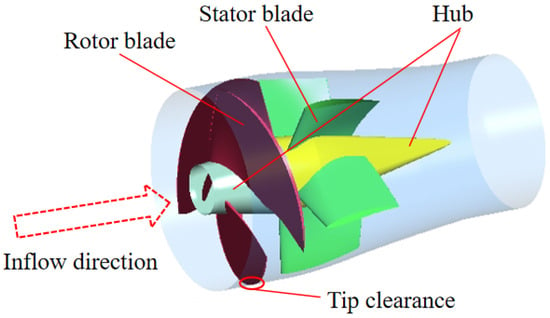
Figure 1.
Three-dimensional model of the water-jet pump.
2.3. Boundary Conditions
Fluent 2020 R2 software was used to simulate the high-speed water-jet pump numerically, and the SST k–ω turbulence model was adopted. The high-speed water-jet pump’s boundary conditions must be set correctly to ensure reliable calculation results. Figure 2 shows the boundary conditions of a high speed water jet propulsion pump. The inlet surface of the flow field was set as the velocity inlet; the outlet of the inlet control body and the outlet of the straight pipe nozzle section were set as the pressure outlet; the pressure value was 1 atm. The two sides and bottom surfaces of the control body were set as opening boundary conditions, and the other boundaries were set as “no-slip wall” surfaces. In the steady-state numerical simulation calculation, the impeller region was set as the rotating region, and the inlet control body, inlet channel, diffuser, and straight pipe nozzle segment were set as the stationary region. The interface between the dynamic and stationary components was the “frozen rotor interface”. In order to improve the simulation accuracy, in the transient calculation, the steady-state calculation result was taken as the initial field, and the above “frozen rotor interface” was changed to “transient rotor stator”. Two mesh interfaces were formed before and after the impeller to simulate the dynamic and stationary interference flow field. The time step was 0.0005 s, the number of iterations in each time step was 100, and the convergence residual was 10−5.
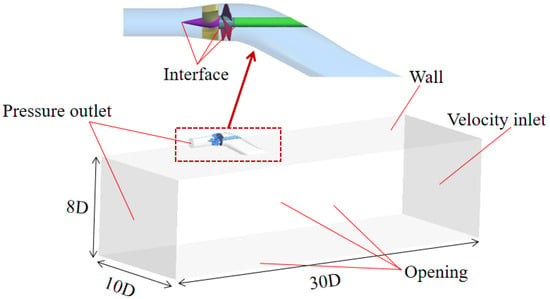
Figure 2.
Boundary conditions.
2.4. Mesh Division and Mesh Independence Test
The impeller, diffuser, and outlet extension section used structured mesh, and the inlet channel and inlet control body used polyhedral mesh. Local encryption and boundary layer encryption were carried out at the same time. The whole domain of the water-jet pump was divided into five different mesh schemes, and the thrust coefficient, head coefficient, and power coefficient were used as evaluation indices to verify the mesh independence. the mesh division of the calculation domain is shown in Figure 3 and the mesh schemes and corresponding calculation outcomes are presented in Figure 4 and Figure 5.
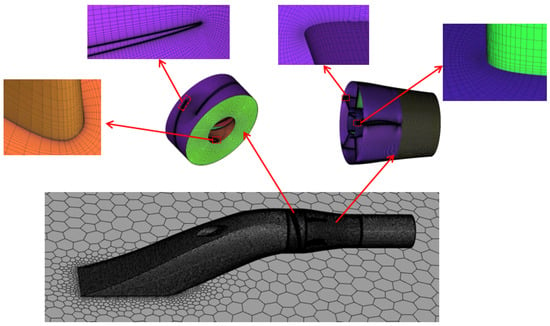
Figure 3.
Meshing generation.

Figure 4.
Mesh sensitivity.
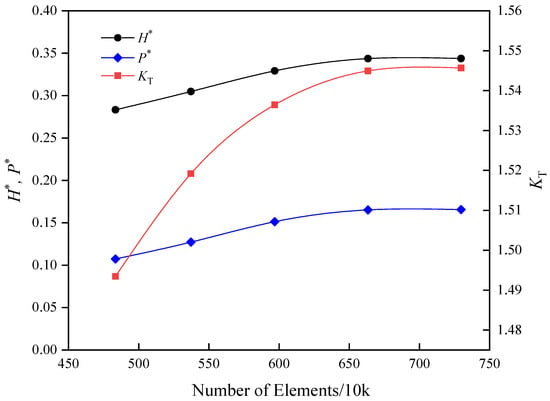
Figure 5.
Mesh independence verification.
The number of meshes directly affects the accuracy of the numerical calculation results. Generally speaking, a higher number of meshes leads to more precise calculation results of pressure and efficiency. Nevertheless, once the number of meshes surpasses a certain point, it no longer affects the aforementioned parameters. Figure 4 shows the five grid partitioning schemes and details the specific number of grids for each hydraulic component, and Figure 5 shows the variation trend of thrust coefficient KT, head coefficient H*, and power coefficient P* with the number of meshes in the design condition of the water-jet pump (n = 6000 r/min). The thrust coefficient KT, head coefficient H*, and power coefficient P* are defined as follows:
Thrust coefficient KT:
Head coefficient H*:
Power coefficient P*:
where T is the thrust generated by the water-jet pump; ρ is the density of water, kg/m3; D is the impeller diameter of the water-jet pump, m; g is the acceleration of gravity, m/s2; n is the speed of the impeller, rad/s. H is the head of the water-jet pump, m; P is the shaft power of the impeller. When the number of meshes is greater than 6.7 million, the thrust coefficient KT, head coefficient H*, and power coefficient P* tend to be stable. Considering the economy and calculation accuracy, the number of meshes was finally determined to be 6.7 million.
In the process of the CFD calculation, the function of y+ is reflected in the calculation of the height of the first layer of mesh nodes in the process of mesh division, and its size is related to the capture of the viscous bottom layer. As shown in Table 1, the y+ of the impeller, diffuser, inlet channel, and straight pipe nozzle were all within the range [0, 30], with average values of 24.4, 37.81, 22.31, and 36.4, Figure 6 shows the corresponding y+ distribution. respectively, meeting the calculation requirements of the SST k–ω turbulence model.

Table 1.
Mesh y+ value of key components of the water-jet pump.
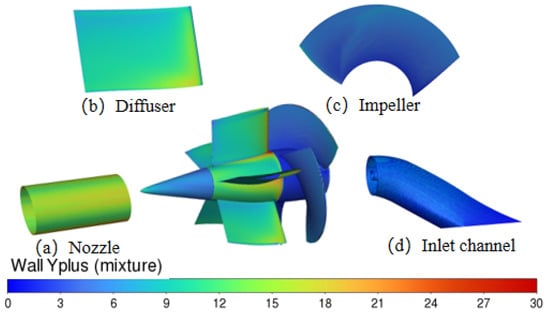
Figure 6.
The y+ values of the different hydraulic components.
3. Experimental System and Method
3.1. Experimental System
This experiment on external characteristics and cavitation was conducted within a closed experimental system, mainly comprising of a pressure stabilizer tank, booster pump, frequency converter, electromagnetic flowmeter, inlet and outlet pressure measuring pipe, valve, high-speed water-jet pump prototype, circulation pipeline, motor, gear box, pressure transmitter, TPA measuring instrument, etc. The electromagnetic flowmeter was a DN300 E-magC from Kaifeng Instrument Company Limited, with an accuracy of ±0.3%. The pressure transmitter was made up of three Shanghai Welltech WT2000GP models with a measuring range of 0~1.6 MPa, 0~2.5 MPa, and 0~4.0 MPa, respectively, and the maximum allowable error was ±0.1%. The torque and speed sensor of the Hunan Xiangyi torque instrument were selected, the model was XSR21Y-T2B3A1A1MS2V0N, and the accuracy was ±0.05%. The instruments used in the experiment were inspected and reported by the Institute of Metrology Science to ensure the accuracy of the experiment. The experimental system’s principle diagram is shown in Figure 7a while the physical diagram can be seen in Figure 7b.

Figure 7.
Experimental bench. (a) Experimental bench three dimensional model. (b) Experimental bench field diagram.
3.2. Experimental Methods and Results
The pump performance experiment was to determine the relationship between the head, shaft power, efficiency, and flow rate of the water-jet pump prototype. Before the pump performance experiment, the water-jet pump prototype should be run at the specified speed and working range of the operating points. During the operation experiment, check the bearing, seal, noise, and vibration of the water-jet pump prototype. The performance experiment was carried out according to the method of constant speed and variable flow. The experimental condition points should be reasonably distributed on the entire performance curve, and the number of measurement points should not be less than 7. The performance experiment should start from the state of a large flow point with a large valve opening, and then gradually reduce the flow to the minimum experimental condition point. At least 60% of the design flow rate of the model pump should be tested. The experiment should also be carried out under the condition of no cavitation, and there should be sufficient stabilization time between the two operating conditions. After stabilization, a set of data including the flow rate, head, speed, and shaft power should be measured at the same time, and finally the data report of the water-jet pump prototype can be obtained. The comparison of external characteristics is shown in Figure 8a. The efficiency formula is defined as follows:
where Q is the flow rate of the water jet pump. After the experimental system is filled with water, the booster pump should be started and the system pressurized to 2.5 MPa. The motor may then be started, and the frequency of the inverter adjusted to the rated speed of the water-jet pump. Once the system is running stably, the TPA tester should be started in order to collect and record test values for the flow, pressure, speed, torque, and other necessary parameters. At the same time, the TPA tester simultaneously calculates and analyzes the inlet and outlet pressure difference in real-time, and gathers test values under operating conditions of 2.5 MPa. Then, the pressure in the circulating pipeline is gradually decreased and several suitable pressure levels are chosen based on the alterations in the experimental outcomes in the range of 2.5 MPa–0 MPa. The aforementioned measures are repeated until H* diminishes by 3%. the cavitation experimental outcomes under distinct system pressures are collected to complete the cavitation experiment. The cavitation curve represented in Figure 8b shows the results. The cavitation number is:
where is the inlet pressure, is the outlet pressure, and is the flow velocity of the water-jet pump.
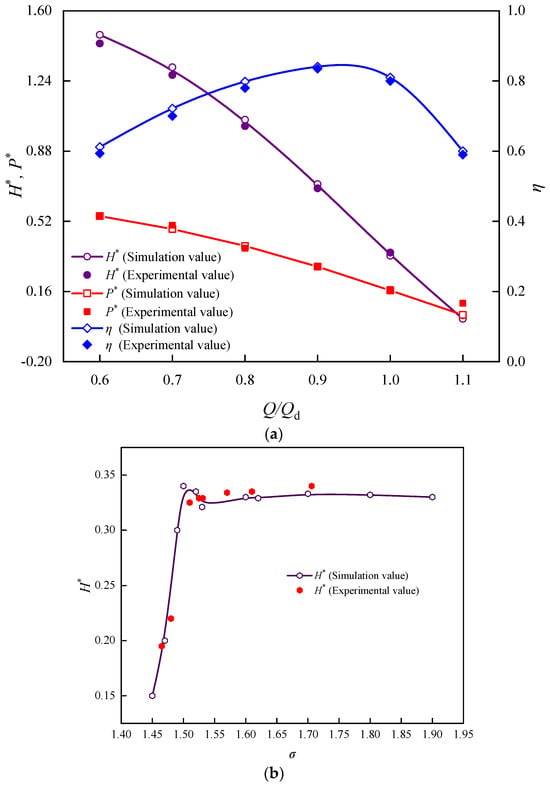
Figure 8.
Comparison of the experimental results and numerical simulation results of the water-jet pump. (a) External characteristic curve of the water-jet pump. (b) Cavitation performance curve of the water-jet pump.
It can be seen from Figure 8 that the experimental results of the head coefficient H*, power coefficient P*, and cavitation number σ of the high-speed water-jet pump were similar to the simulation results, with an error of less than 5%. The calculation method adopted in this paper can provide a reference for the subsequent transient simulation.
4. Research Program
In order to fully consider the influence of the rotating acceleration of the impeller and the change in ship speed, the transient change rule was applied by using a custom formula. For water-jet pumps, there are two common modes of acceleration: linear acceleration and exponential acceleration. This paper mainly studied the effects of acceleration time and variable speed mode on the transient hydrodynamic characteristics, so linear acceleration was selected, and its basic formula is as follows:
where n0 is the initial velocity of the impeller, rad/s; na is the velocity acceleration of the impeller, rad/s2; t is a moment in the acceleration of the impeller, s.
In Figure 9, the start times were 1 s, 2 s, and 3 s, and the speed increased linearly. The speed increased from 0 r/min to 6000 r/min, and after the start-up process was over, the ship ran at the highest speed. In Figure 10, the acceleration times were 0.5 s, 1 s, and 1.5 s, and the speed increased linearly from 3000 r/min to 6000 r/min. After the acceleration process, the ship ran at the highest speed.
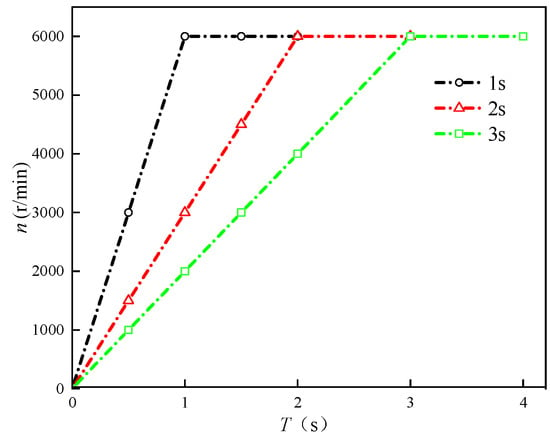
Figure 9.
The variation curves of rotation speed and ship speed under different start-up times.
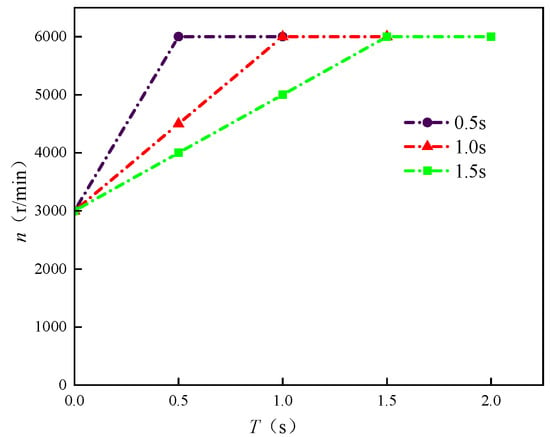
Figure 10.
The variation curves of rotation speed and ship speed under different acceleration times.
5. Calculation Results and Analysis
5.1. Transient Thrust Performance Analysis
Dimensionless thrust is used to analyze the propulsion performance of the water-jet pump, the maximum thrust value during the 1 s start-up process is T0, and the dimensionless thrust T* = T/T0. Figure 11 shows the trend of thrust over time during the start-up process of the high-speed water-jet pump, and Figure 12 shows the trend of thrust over time during the acceleration process of the high-speed water-jet pump. It can be seen from the figure that the thrust change trend of the water-jet pump during the start-up process is consistent with that during the emergency acceleration process.
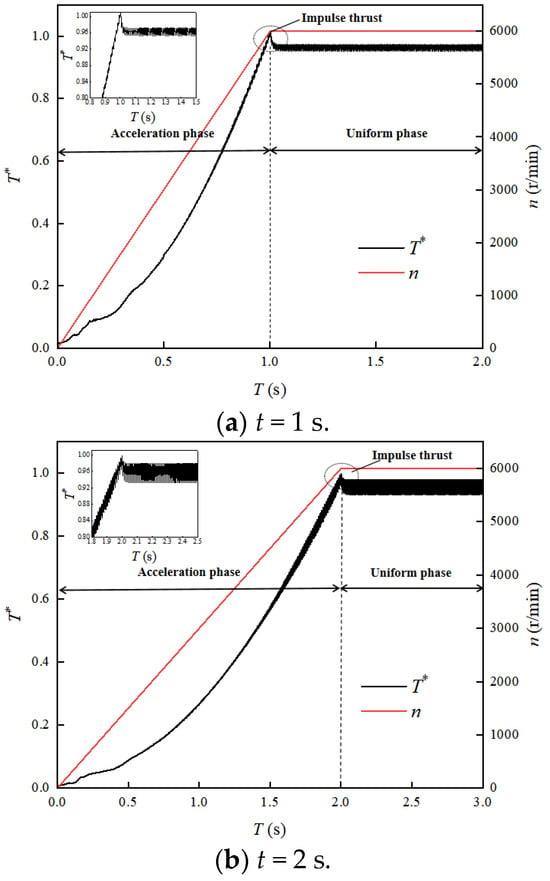
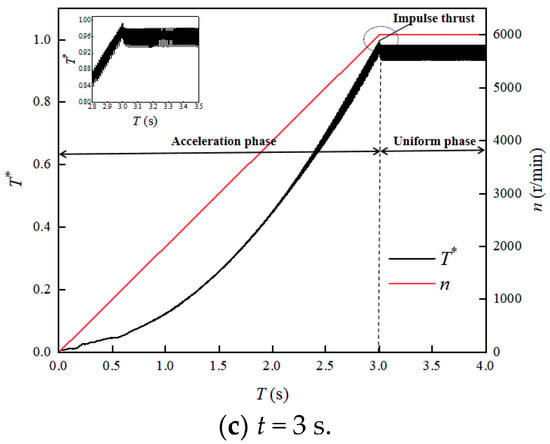
Figure 11.
Thrust change trend with different start-up times.
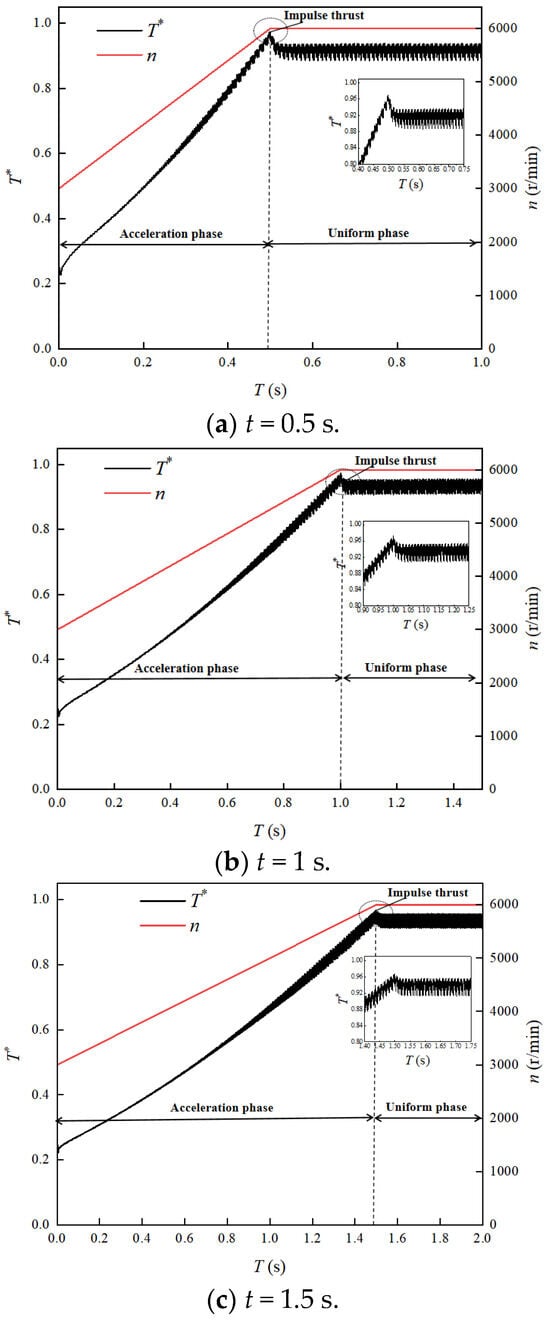
Figure 12.
Thrust change trend with different acceleration times.
The entire speed change process can be divided into an acceleration stage and a stability stage. In the acceleration stage, the thrust increases rapidly with the increase of the speed. When the speed reaches 6000 r/min, the thrust appears to be significantly greater than the thrust in the stable stage at the moment of the end of the acceleration. In the stable stage, the impact thrust gradually decreases to the stable value. By comparing the thrust characteristics of different acceleration times, it was found that the impact thrust decreased with the increase in the acceleration time, and the impact thrust of 1 s, 2 s, and 3 s was T0, 0.987T0, and 0.981T0, respectively. When the acceleration time was 0.5 s, 1 s, and 1.5 s, the impact thrust was 0.967T0, 0.961T0, and 0.955T0, respectively. This indicates that high acceleration can easily lead to greater impact thrust.
In the stable operation of the water-jet pump, the thrust of the water-jet pump itself is equal to the resistance of water, while in the acceleration stage, the thrust T of the sprinkler itself must be greater than the resistance of water. In the operation process, the instantaneous head H and the instantaneous hydraulic loss h are always equal, and the instantaneous thrust is positively correlated with the instantaneous head. In the start-up process, the instantaneous head is composed of the Euler equation and the instantaneous additional head. The instantaneous additional head is positively correlated with the acceleration, so the instantaneous head reaches the highest at the moment of the end of acceleration, and then continues to decrease, and the thrust change trend corresponds to it.
After the impact thrust is reached, the stability of the high-speed water-jet pump thrust will be achieved after a buffering period. The buffer time for the 1 s, 2 s and 3 s start-up times were 0.0394 s, 0.0375 s, and 0.0282 s, respectively. When the acceleration time was 0.5 s, 1.0 s, and 1.5 s, the buffer time was 0.0330 s, 0.0273 s, and 0.0230 s, respectively, which indicates that it takes a longer time to reach the stabilization stage after acceleration with high starting acceleration. At the same acceleration, the buffer time of the acceleration process is longer than that of the start-up process. Through the above analysis, it can be seen that the thrust has an obvious transient effect in the start-up process and acceleration process, both of which are later than the speed reaches the stable state. The greater the acceleration, the more serious the thrust lags behind the speed.
5.2. Evolution Characteristics of the Flow Field
In order to analyze the flow field evolution law of the impeller during the variable speed process, the 50% spanwise surface of the impeller was taken, that is, the middle position of the impeller flow channel, as shown in Figure 13.
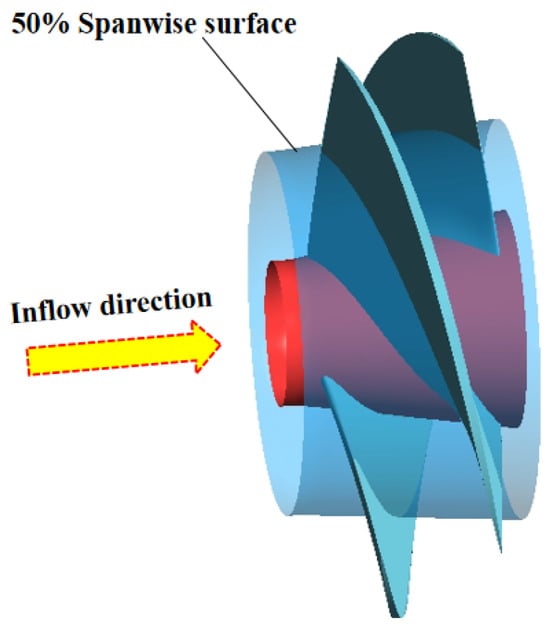
Figure 13.
Schematic diagram of 50% spanwise surface of the impeller.
In the start-up process of the water-jet pump, the speed increased from 0 r/min to 6000 r/min under three start-up times, and the evolution law of the flow field was not significantly different, as was the acceleration process. This section compares and analyzes some of the operating conditions during the 2 s start-up process and 1 s acceleration process of the high-speed water-jet pump. Figure 14 shows the 50% radial pressure distribution of the impeller, the vortex core of the impeller suction surface, and the velocity distribution of the vortex core with the speed change. The threshold of the vortex core was set at 0.0035. Figure 14a shows the 2 s start-up process and Figure 14b shows the 1 s acceleration process.
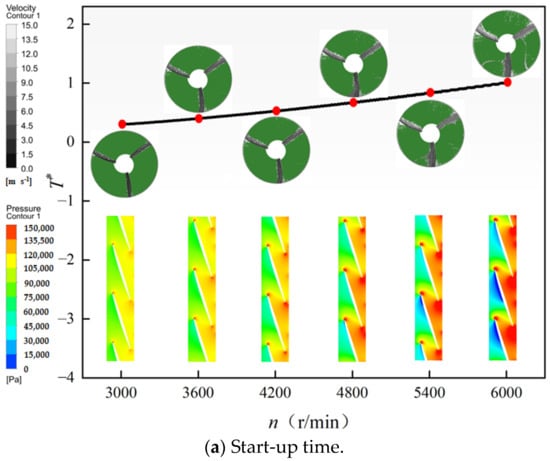
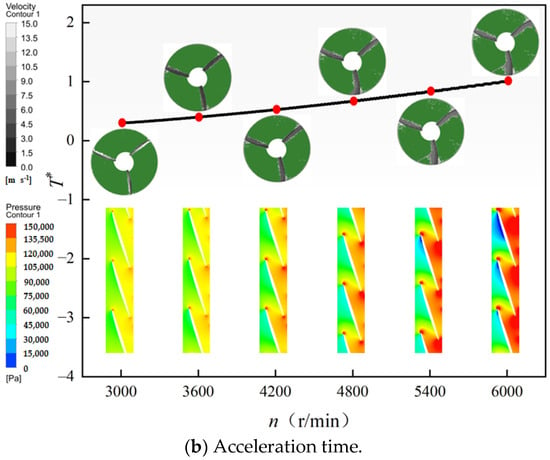
Figure 14.
Velocity distribution and pressure distribution at 50% spread direction of the impeller.
The pressure distribution on the blade surface during the start-up process is shown in Figure 14a. When the speed reached 3000 r/min, the low-pressure area of the suction surface was mainly in the inlet area of the blade, especially on the side of the shroud, which was caused by the high speed of the impeller at the shroud. The pressure increased gradually along the flow direction, and the blade outlet side pressure was high, which indicates that the flow inside the water-jet pump was relatively stable. The core of the vortex was primarily concentrated at the impeller inlet with limited range and velocity, resulting from the flow impact. In the early stage of the start-up process, due to the low speed, there was an obvious reflux phenomenon at the inlet of the impeller. As the speed gradually increased, the reflux also gradually weakened, and the vortex core area at the blade inlet gradually expanded along the suction surface of the blade.
When the speed reached 4800 r/min, the velocity of the vortex core region increased, the pressure at the impeller inlet further decreased, and the low-pressure region further expanded due to the double influence of the expansion of the vortex core area and the work conducted by the blades. When the speed reached 6000 r/min, the pressure on the back of the impeller rose rapidly, and the high-pressure area was almost all over the back of the impeller. At the same time, the low-pressure area developed from the shroud side of the SS of the impeller inlet to the middle of the impeller. With the expansion of the vortex core area, the vortex core spread to the middle of the impeller with the flow. This was due to the transient effect during the start-up process of the water-jet pump, and the flow inside the impeller was not completely stable. After the flow was stable, the vortex core area gradually decreased and was eventually eliminated.
As can be seen from Figure 14, when the acceleration was the same, the velocity distribution and pressure distribution evolution law of the start-up process and the acceleration process were similar. It is unnecessary to go into detail here. By comparing the pressure diagram of the 2 s start-up process and 1 s acceleration process, it can be seen that the high-pressure region of the 2 s start-up process was small, the vortex core region was large, and the ability to do work was weaker. This is because at the same acceleration, the start-up process had stronger hysteresis, longer lag times for flow and head, and a less unstable flow.
5.3. Cavitation Evolution Characteristics
In order to analyze the development process of cavitation in the impeller during the start-up process, the evolution history of cavitation in the impeller is presented in Table 2. It can be seen that the trend of cavitation evolution in different start-up processes was basically the same. The cavitation phenomena on the three blades were different because of the influence of the non-uniform flow at the inlet of the water-jet pump, the flow velocity and direction of the fluid were not uniform, and the dynamic pressure distribution at different positions on the blades was different, resulting in different degrees of cavitation on the blades. In the early stage of the start-up process, due to the low speed, the flow field inside the impeller did not appear as a low-pressure area, and there was no cavitation phenomenon, so the corresponding picture is not given in the table. When the speed reached 3000 r/min, that is, 0.5 times the design speed, a small amount of cavitation appeared on the inlet edge of the suction surface of the blades. When the speed continued to increase, the cavitation area continued to expand and slowly spread from the leading edge of the blade to the middle of the impeller. When the speed increased to 4800 r/min, the cavitation spread speed increased rapidly, and when the speed reached 6000 r/min, severe cavitation appeared at the suction surface of the impeller blades. At this time, the cavity volume fraction of the 1 s start-up process was 7.32%, that of the 2 s start-up process was 5.84%, and that of the 3 s start-up process was 5.32%. The cavitation phenomena of different start-up times were compared and analyzed. The smaller the start-up time at the same speed, the larger the cavitation area. The larger the vacuole volume fraction, an appropriate reduction in acceleration during the start-up process is helpful to restrain the development of cavitation during the start-up process.

Table 2.
Evolution of cavitation during the variable speed process.
In the acceleration process of the high-speed water-jet pump, the trend of cavitation evolution is basically the same as that of the start-up process. When the speed reached 6000 r/min, the vacuole volume fraction of the 0.5 s acceleration process as 6.86%, the 1 s acceleration process was 5.04%, and the 1.5 s starting process was 4.23%. The shorter the acceleration time, the larger the cavitation region and the more serious the cavitation.
Compared with the start-up process and acceleration process under the same acceleration, the cavitation phenomenon in the start-up process was more obvious and serious, which was due to the longer time required in the stage acceleration process; the water-jet pump could gradually increase to the design speed at a lower speed, from 3000 r/min to 6000 r/min, and the flow rate changed little. The fluid can adapt to the change and run steadily, while with the flow surge during the start-up process, the pressure difference generated by the impeller will cause the gas solubility in the liquid to decrease, resulting in gas precipitation to form bubbles.
From the above analysis, it can be seen that the development of cavitation in the variable speed process can be effectively inhibited by using a larger start-up time and acceleration time. Under the same acceleration, the anti-cavitation performance of the acceleration process is better. In the actual operation of the water-jet pump, the segmented acceleration eventually reaches the design speed, which can better restrain the generation of cavitation.
6. Conclusions
The effect of acceleration time on the transient characteristics of the variable speed process of a high-speed axial flow water-jet pump was studied numerically. The main conclusions are as follows:
- (1)
- The variable speed process of the high-speed water-jet pump can be divided into the acceleration stage and stability stage. There is an obvious transient effect in the process of the variable speed, and the thrust reaches the stable state later than the speed. The buffer times for start-up times of 1 s, 2 s, and 3 s were 0.0394 s, 0.0375 s, and 0.0282 s, respectively; the buffer times for acceleration times of 0.5 s, 1.0 s, and 1.5 s were 0.0330 s, 0.0273 s, and 0.0230 s, respectively. The greater the acceleration, the more serious the flow rate and thrust lag behind the speed, and the greater the impact thrust.
- (2)
- In the process of variable speed of the high-speed water-jet pump, the vortex core area of the suction surface first appears at the inlet, on the side of the shroud of the impeller, and increases with the increase in the speed, and develops toward the middle of the impeller. However, after the flow is stabilized, the vortex core region will gradually decrease and eventually be eliminated.
- (3)
- When the speed reaches 0.6 times of the design speed, cavitation begins to occur at the leading edge of the blade, and the cavitation area increases with the increase in speed. Under the design speed, that is, 6000 r/min, the cavitation volume fraction of the 1 s start-up process is 7.32%, the 2 s start-up process is 5.84%, the 3 s start-up process is 5.32%, and the 0.5 s acceleration process is 6.86%. The cavitation volume fraction of the 1 s acceleration process is 5.04%, and that of the 1.5 s acceleration process is 4.23%. When the same speed is reached, the greater the acceleration, the more serious the cavitation, and the weaker the blade’s ability to perform work.
- (4)
- In the high-speed water-jet pump, the lag effect brought by the transient effect cannot be ignored. Compared with the start-up process and acceleration process under the same acceleration, it was found that the lag effect will be slightly lower than the start-up process during the acceleration process. Under the same acceleration, the buffer time required for the start-up process is 19.3~22.6% longer than that for the acceleration process. This also leads to a smaller range of the vortex core area during the acceleration process, stronger anti-cavitation ability, and more stable flow when the speed reaches 6000 r/min. When the high-speed water-jet pump is used, it is recommended that the speed is slowly increased in the segmentation acceleration mode.
In this paper, we analyzed the transient hydrodynamic characteristics of the high-speed axial-flow water-jet pump in the variable speed process, which provides theoretical support for the further study of high-speed water-jet pumps, but there are still the following shortcomings:
- (1)
- Environmental factors were not considered in this paper, which will have a great impact on the actual operation of the water-jet pump. For example, cavitation is related to steam pressure and corresponding temperature. If the appropriate temperature is selected, cavitation can be reduced.
- (2)
- Multi-parameter analysis and optimization are indispensable for the in-depth study of the water-jet pump, but relevant research was not involved in the paper.
- (3)
- This paper mainly studied the operation characteristics and internal flow characteristics of a high-speed water-jet pump through numerical simulation, and did not conduct experimental discussions on the internal flow field.
In the future, we will conduct hydraulic development for high-speed water-jet pumps under special use conditions such as a special seawater medium and special ambient temperature, and conduct in-depth discussions on multi-parameter performance optimization. In numerical simulation verification, we will use the LES method to better characterize complex flows such as vortices as well as carry out internal flow visualization experiments and other experimental studies where the evolution law of flow structure in water-jet pumps will be further revealed.
Author Contributions
Methodology, R.Z.; Software, W.S.; Validation, H.L.; Investigation, D.Y. and Y.D.; Resources, G.G.; Data curation, Q.F.; Writing—original draft, W.S. All authors have read and agreed to the published version of the manuscript.
Funding
This research was funded by the National Natural Science Foundation of China (U20A20292).
Data Availability Statement
The data presented in this study are available on request from the corresponding author. The data are not publicly available due to confidentiality of research projects.
Conflicts of Interest
The authors declare no conflict of interest.
References
- Cao, L.L.; Che, B.X.; Hu, L.J.; Wu, D.Z. Design method of water jet pump towards high cavitation performances. IOP Conf. Ser. Mater. Sci. Eng. 2016, 129, 012067. [Google Scholar] [CrossRef]
- Fu, Y. A Review on Hydrodynamic Performance and Design of Pump-Jet: Advances, Challenges and Prospects. J. Mar. Sci. Eng. 2022, 10, 1514. [Google Scholar]
- Han, W.; Chen, R.; Li, R.; Su, M.; Qiang, Y.; Han, J.; Li, H. Acoustic characteristics of water-jet propulsion with screw mixed-flow pump under quasi-submerged state. Mod. Phys. Lett. B 2020, 34, 205373. [Google Scholar] [CrossRef]
- Han, W.; Shang, T.; Su, M.; Gong, C.; Meng, B. Direct Sailing Variable Acceleration Dynamics Characteristics of Water-Jet Propulsion with a Screw Mixed-Flow Pump. Appl. Sci. 2019, 9, 4194. [Google Scholar] [CrossRef]
- Wu, J.; Cheng, L.; Luo, C.; Wang, C. Influence of External Jet on Hydraulic Performance and Flow Field Characteristics of Water Jet Propulsion Pump Device. Shock. Vib. 2021, 2021, 1–15. [Google Scholar] [CrossRef]
- Huang, R.; Yu, A.; Ji, B.; Zhou, J.; Zhai, Z.; Luo, X. Cavitating flow features in a water-jet pump under different upstream conditions. In Proceedings of the 16th International Symposium on Transport Phenomena and Dynamics of Rotating Machinery, Honolulu, HI, USA, 10–15 April 2016. [Google Scholar]
- Wang, J.; Cheng, H.; Xu, S.; Ji, B.; Long, X. Performance of cavitation flow and its induced noise of different jet pump cavitation reactors. Ultrason. Sonochemistry 2019, 106, 215–225. [Google Scholar] [CrossRef]
- Zhao, G.; Liang, N.; Zhang, Y.; Cao, L.; Wu, D. Dynamic behaviors of blade cavitation in a water jet pump with inlet guide vanes: Effects of inflow non-uniformity and unsteadiness. Appl. Ocean. Res. 2021, 117, 102889. [Google Scholar] [CrossRef]
- Yang, D.; Huang, Z.; Guo, A.; Xu, J.; Jiao, L. Effect of Tip Clearance on Hydraulic Performance of Water-jet Pump. J. Phys. Conf. Ser. 2017, 916, 012020. [Google Scholar] [CrossRef]
- Yang, Y.; Wu, S.; Wang, C.; Jiao, W.; Ji, L.; An, C.; Ge, J. Effect of effuser throat diameter on the internal flow structure and energy characteristics of the jet pump. Energy Rep. 2023, 9, 2075–2086. [Google Scholar] [CrossRef]
- Zhang, Y.; Han, J.; Huang, B.; Zhang, D.; Wu, D. Excitation force on a pump-jet propeller: The effect of the blade number. Ocean. Eng. 2023, 281, 114727. [Google Scholar] [CrossRef]
- Lu, Y.; Tan, L.; Han, Y.; Liu, M. Cavitation-vibration correlation of a mixed flow pump under steady state and fast start-up conditions by experiment. Ocean. Eng. 2022, 251, 111158. [Google Scholar] [CrossRef]
- Duplaa, S.; Coutier-Delgosha, O.; Dazin, A.; Roussette, O.; Caignaert, G. Experimental Study of a Cavitating Centrifugal Pump During Fast Startups. J. Fluids Eng. 2010, 132, 365–368. [Google Scholar] [CrossRef]
- Zhang, Y.-L.; Zhu, Z.-C.; Zhao, Y.-J.; Wu, J.; Zhou, F.-L. Comparative Experiments on a Self-priming Pump Delivering Water Medium During Rapid and Slow Starting Periods. Iran. J. Sci. Technol. Trans. Mech. Eng. 2021, 45, 1007–1019. [Google Scholar] [CrossRef]
- Zhang, Y.-L.; Zhu, Z.-C.; Dou, H.-S.; Cui, B.-L.; Li, Y. Experimental and Theoretical Study of a Prototype Centrifugal Pump during Startup Period. Int. J. Turbo Jet-Engines 2013, 30, 173–177. [Google Scholar] [CrossRef]
- Wu, D.; Wang, L.; Hao, Z.; Li, Z.; Bao, Z. Experimental study on hydrodynamic performance of a cavitating centrifugal pump during transient operation. J. Mech. Sci. Technol. 2010, 24, 575–582. [Google Scholar] [CrossRef]
- Li, W.; Ji, L.; Shi, W.; Li, E.; Ma, L.; Yang, Z. Particle image velocimetry experiment of the inlet flow field in a mixed-flow pump during the startup period. Proc. Inst. Mech. Eng. Part. A J. Power Energy 2019, 234, 300–314. [Google Scholar] [CrossRef]
- Li, Q.; Ma, X.; Wu, P.; Yang, S.; Huang, B.; Wu, D. Study on the Transient Characteristics of the Centrifugal Pump during the Startup Period with Assisted Valve. Processes 2020, 8, 1241. [Google Scholar] [CrossRef]
- Gaggero, S.; Martinelli, M. Design and analysis of pumpjet propulsors using CFD-based optimization. Ocean. Eng. 2023, 277, 114304. [Google Scholar] [CrossRef]
- Fu, S.; Zheng, Y.; Kan, K.; Chen, H.; Han, X.; Liang, X.; Liu, H.; Tian, X. Numerical simulation and experimental study of transient characteristics in an axial flow pump during start-up. Renew. Energy 2020, 146, 1879–1887. [Google Scholar] [CrossRef]
- Zheng, F.; Zhang, X.; Chen, T.; Huang, B.; Xu, J.; Wang, G. Strong transient characteristics in axial flow waterjet pump during rapid starting period with special emphasis on saddle zone. Ocean. Eng. 2023, 269, 113506. [Google Scholar] [CrossRef]
- Ren, Z.; Sun, M.; Zhang, J.; Wang, X.; Huang, Z.; Xu, J.; Huang, C. Start-up strategy of mixed-flow pump system with impulse operation. Ocean. Eng. 2023, 277, 114058. [Google Scholar] [CrossRef]
- Li, K.; Li, W.H. Study on the Acceleration Process of Water-Jet Propulsion Ship. Appl. Mech. Mater. 2013, 263, 756–761. [Google Scholar] [CrossRef]
- Wu, X.-F.; Li, M.-H.; Liu, H.-L.; Tan, M.-G.; Lu, Y.-D. Performance of water-jet pump under acceleration. Int. J. Nav. Archit. Ocean. Eng. 2021, 13, 794–803. [Google Scholar] [CrossRef]
- Chang, H.; Hong, S.; Wang, C.; Peng, G.; Fan, F.; Ye, D. Investigation on the Transient Characteristics of Self-Priming Pumps with Different Hub Radii. Machines 2021, 9, 311. [Google Scholar] [CrossRef]
- Feng, J.; Ge, Z.; Zhang, Y.; Zhu, G.; Wu, G.; Lu, J.; Luo, X. Numerical investigation on characteristics of transient process in centrifugal pumps during power failure. Renew. Energy 2021, 170, 267–276. [Google Scholar] [CrossRef]
- Wang, H.; Hu, Q.; Yang, Y.; Wang, C. Performance differences of electrical submersible pump under variable speed schemes. Int. J. Simul. Model. 2021, 20, 76–86. [Google Scholar] [CrossRef]
- Zuo, Z.; Tan, L.; Shi, W.; Chen, C.; Ye, J.; Francis, E.M. Transient Characteristic Analysis of Variable Frequency Speed Regulation of Axial Flow Pump. Sustainability 2022, 14, 11143. [Google Scholar] [CrossRef]
- Han, W.; Zhang, T.; Su, Y.L.; Chen, R.; Han, Y. Transient Characteristics of Water-Jet Propulsion with a Screw Mixed Pump during the Startup Process. Math. Probl. Eng. 2020, 2020, 5691632. [Google Scholar] [CrossRef]
- Constantinescu, G. Rough Wall Flow Using k − ω Turbulence Model in FLUENT. Am. Soc. Civ. Eng. 2012. [Google Scholar] [CrossRef]
- Wu, Q.; Huang, B.; Wang, G.; Cao, S.; Zhu, M. Numerical modelling of unsteady cavitation and induced noise around a marine propeller. Ocean. Eng. 2018, 160, 143–155. [Google Scholar] [CrossRef]
- Fuyi, Z.; Hang, L.; Tairan, C.; Qin, W.; Biao, H.; Guoyu, W. Transient Characteristics of Start-up Process of an Axial Flow Water-jet Propeller. Acta Armamentarii 2021, 42, 1592. [Google Scholar]
Disclaimer/Publisher’s Note: The statements, opinions and data contained in all publications are solely those of the individual author(s) and contributor(s) and not of MDPI and/or the editor(s). MDPI and/or the editor(s) disclaim responsibility for any injury to people or property resulting from any ideas, methods, instructions or products referred to in the content. |
© 2023 by the authors. Licensee MDPI, Basel, Switzerland. This article is an open access article distributed under the terms and conditions of the Creative Commons Attribution (CC BY) license (https://creativecommons.org/licenses/by/4.0/).



















